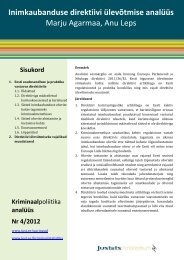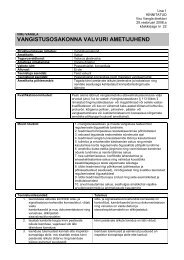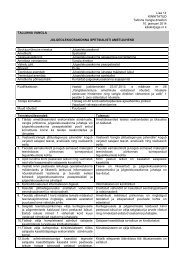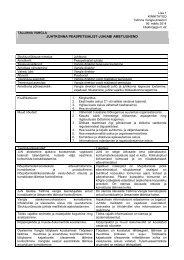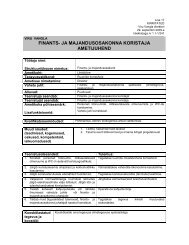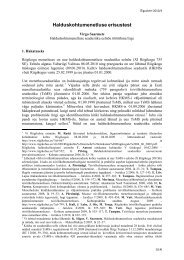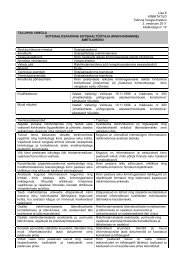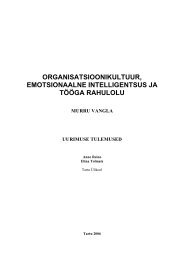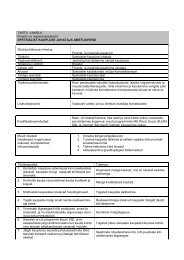11. Retsidiivsus Eestis - Justiitsministeerium
11. Retsidiivsus Eestis - Justiitsministeerium
11. Retsidiivsus Eestis - Justiitsministeerium
Create successful ePaper yourself
Turn your PDF publications into a flip-book with our unique Google optimized e-Paper software.
RETSIDIIVSUS EESTIS 2010<br />
1. RECIDIVISM IN ESTONIA – SUMMARY<br />
RETSIDIIVSUS EESTIS 2010<br />
Figure 1. The one-year recidivism rate based on the 2007 database<br />
1.2. Recidivism upon release from prison<br />
High recidivism rate of people released from prison may refer to several<br />
circumstances. First, this refers to the inefficiency of prison sentence as a sanction<br />
targeted at changing the behaviour, on the other hand this may also show<br />
that criminal offenders with higher risk, the so-called predisposed offenders<br />
are the ones who are imprisoned in case of whom the prison does not have a<br />
shock effect either and for whom criminal behaviour is a natural part of their<br />
life which they even do not want to give up.<br />
Within six months after release from prison, already every fourth released<br />
person had been interrogated as a suspect of committing a new crime; within<br />
a year and a half, a suspicion was filed against half of former prisoners and<br />
within three years against more than 60%. Data indicate that the recidivism<br />
rate of people released from prison has somewhat decreased over the years:<br />
when 43% of people released in 2004 committed a new criminal offence<br />
within a year and 41% in 2005 and 2006, then 40% of people released in 2007<br />
committed new criminal offences.<br />
The recidivism rate for people released from prison is the highest among<br />
those who have fully served their sentence, every second former prisoner from<br />
them will commit a new criminal offence within a year – this indicator has<br />
remained a steady 48%-49% during four years (2004 – 2007), in spite of the<br />
fact that the proportion of people released after serving their sentence to all<br />
released people has decreased from 82% to 49%.<br />
Figure 2. The one-year recidivism rate based on the manner of release (people<br />
released in 2007)<br />
In 2007, the 12-month recidivism rate for people who had served shock imprisonment53<br />
was 30% and this has fallen over the years, just like the number of<br />
these people whom the shock imprisonment was imposed. In 2004–2006, the<br />
recidivism rate for people prematurely released remained in the range 22% to<br />
24%, however, increased in case of people released in 2007 up to 34% – this<br />
increase was related to a new regulation of law that was accompanied by an<br />
almost twofold increase of the number of prematurely released people. In case<br />
of electronic surveillance the recidivism rate was 20% in 2007 that is somewhat<br />
less than in case of other cases of premature release.<br />
The estimates of Estonian prosecutors and judges, who think that taking<br />
into consideration the recidivism risk is most important when the premature<br />
release of a person is considered, are also in accordance with recidivism indicators<br />
– as is seen from the increase in the relevant indicator in 2007, changes<br />
in procedural practice may bring along the growth of commission of new<br />
criminal offence. In the poll carried out in the framework of this study half of<br />
questioned prosecutors and judges thought that underestimation of recidivism<br />
risk occurs in the Estonian procedural practice today in case of premature<br />
release. The cause of this was thought to be that too much significance was<br />
attributed to a person’s behaviour and the prison’s opinion was too much relied<br />
53 Pursuant to § 73 and § 74 of the Penal Code, it is possible to impose the offenders the so-called shock imprisonment<br />
in case of which an offender has to serve only a short-term part of imprisonment (mostly up to 6 months) and he/<br />
she will be released on parole. The purpose of this is to create a shock effect for convicted offender and this way issue<br />
him/her a serious warning concerning further behaviour. It is found during an imprisonment with longer term<br />
(more than a few months) that a person may adjust to prison life and in such a case partial release from serving<br />
the sentence will no longer give the desired effect.<br />
160<br />
161



